What's Scalded Milk? A Comprehensive Guide
Scalded milk is a cooking technique that involves heating milk to just below its boiling point. This process serves several purposes, including killing bacteria, altering the protein structure, and enhancing the flavor and texture of various dishes. If you're curious about scalded milk and how to use it in your cooking, read on for a detailed exploration.
1. Understanding the Scalding Process
Scalding milk involves heating it gently until small bubbles form around the edges of the pot. This temperature is typically around 180°F (82°C), just below the boiling point of milk. At this stage, the milk is hot enough to kill any potentially harmful bacteria present in raw milk without boiling it.
2. Benefits of Scalding Milk
- Safety: Scalding milk helps eliminate any harmful bacteria that may be present, making it safer to consume, especially in recipes that call for uncooked or partially cooked milk.
- Texture Enhancement: Scalding milk denatures the whey proteins, leading to smoother and creamier textures in custards, puddings, and sauces.
- Flavor Improvement: The heating process caramelizes the natural sugars in the milk, resulting in a richer, more complex flavor profile.

whats scalded milk
3. Common Uses of Scalded Milk
- Baking: Scalded milk is often used in baking recipes to activate yeast, dissolve sugar, and create tender baked goods like bread, cakes, and cookies.
- Desserts: It serves as a key ingredient in custards, puddings, and ice creams, providing a silky texture and enhancing the overall flavor.
- Sauces and Soups: Scalded milk is incorporated into creamy sauces and soups to improve their consistency and prevent curdling when added to hot liquids.
4. How to Scald Milk
Follow these simple steps to scald milk effectively:
- Pour the Milk: Pour the desired amount of milk into a heavy-bottomed saucepan.
- Heat Gently: Place the saucepan over medium heat and warm the milk, stirring occasionally to prevent scorching.
- Watch for Signs: Keep an eye on the milk as it heats up. Small bubbles will start to form around the edges of the pot when it reaches the scalding temperature.
- Remove from Heat: Once the bubbles appear, immediately remove the saucepan from the heat to prevent boiling.
- Cool if Necessary: Allow the scalded milk to cool slightly before using it in your recipe, depending on the instructions.

whats scalded milk
5. Tips and Considerations
- Use Fresh Milk: Start with fresh, high-quality milk for the best results.
- Stir Frequently: Stir the milk occasionally while heating to ensure even temperature distribution and prevent sticking.
- Don't Boil: Avoid letting the milk come to a full boil, as this can alter its flavor and texture.
- Adjust for Recipes: Follow recipe instructions carefully, as some recipes may call for scalded milk while others may not.
Conclusion
Scalded milk is a versatile ingredient that plays a vital role in many culinary applications, from baking to making creamy sauces and desserts. By understanding the scalding process and how to incorporate it into your recipes, you can enhance the flavor, texture, and safety of your dishes. Experiment with scalded milk in your cooking adventures to discover the delicious difference it can make!